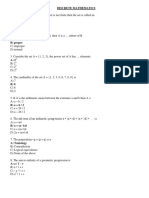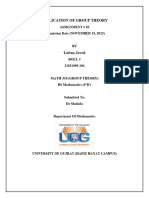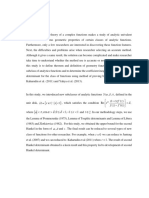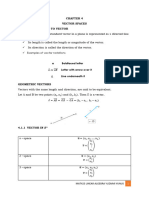0 ratings0% found this document useful (0 votes)
7 viewsGroup Theory Notes Sept 2022
Group Theory Notes Sept 2022
Uploaded by
alextheory notes
Copyright:
© All Rights Reserved
Available Formats
Download as PDF, TXT or read online from Scribd
Group Theory Notes Sept 2022
Group Theory Notes Sept 2022
Uploaded by
alex0 ratings0% found this document useful (0 votes)
7 views3 pagestheory notes
Original Title
GROUP THEORY NOTES SEPT 2022
Copyright
© © All Rights Reserved
Available Formats
PDF, TXT or read online from Scribd
Share this document
Did you find this document useful?
Is this content inappropriate?
theory notes
Copyright:
© All Rights Reserved
Available Formats
Download as PDF, TXT or read online from Scribd
Download as pdf or txt
0 ratings0% found this document useful (0 votes)
7 views3 pagesGroup Theory Notes Sept 2022
Group Theory Notes Sept 2022
Uploaded by
alextheory notes
Copyright:
© All Rights Reserved
Available Formats
Download as PDF, TXT or read online from Scribd
Download as pdf or txt
You are on page 1of 3
GROUP THEORY NOTES SEPT 2022
Definition of Group Theory
Group theory is the study of a set of elements present in a group. For example, the set of
all the integers with addition. If there are a finite number of components, the group is
termed as a finite group, where the number of components is called the order of the
group. A subset of the group which is bounded under any of the group operations is
known as Subgroups. In laymen terms, group theory is the study of the set of components
present in a group, where a group is the acquisition of the components/ elements that are
integrated together to perform some operations on them.
What are the types of group theory?
Group theory has three main historical sources:
1. Number theory
2. Theory of algebraic equations
3. Geometry
What are the properties of group theory?
So, a group holds five properties simultaneously
i) Closure
Closure: If A and B are two components in the group, G, then the product “AB” is
also in “G”
ii) Associative
for all A, B, C are in the group, “G”, then (AB) C= A (BC)
iii) Identity element
iv) Inverse element
v) Commutative.
The commutative property deals with the arithmetic operations of addition and
multiplication. It means that changing the order or position of two numbers
while adding or multiplying them does not change the end result. For example, 4
+ 5 gives 9, and 5 + 4 also gives 9.
What are the 5 types of groups?
1. Formal and Informal Groups.
2. Primary and Secondary Groups.
3. Organized and Unorganized Groups.
4. Temporary and Permanent Groups.
5. Open and Closed Groups.
Applications of Group Theory
Group theory has multiple facets and various beneficial applications within and outside a
broad width of science and mathematics, also groups mount in a number of supposedly
impertinent entities.
1. In Physics, it plays an indispensable role in the determination of the selection rules
for spectroscopic transitions in Atomic and Molecular Spectroscopy.
2. In Chemistry, it is implemented to study and analyze the symmetries and the
crystal structures of molecules, including many physical and chemical properties,
and spectroscopic properties of the molecule. The group theory has turned out to be
a standard and a powerful tool for studying molecular properties in the terms of
molecular orbital theory.
3. In Computer, Group theory, being an eventual and powerful tool for symmetry, has
an ultimate impact on research in robotics, computer vision, computer graphics and
medical image analysis.
4. In Mathematics, it can be used for classification of identical mathematical objects
that possess symmetry, for example in geometric figures ( a circle is highly
symmetric and invariant under any rotation) and in mathematical functions and
operations.
5. For the smooth data transmission, the concept of group, subgroups and cosets are
used in Cryptography and Public Key algorithms.
6. In recent researches, it has exploited in music screening as well.
You might also like
- An Interactive Introduction To Mathematical Analysis-J.lewineDocument526 pagesAn Interactive Introduction To Mathematical Analysis-J.lewineZerina Dragnic100% (1)
- Discrete Mathematics MCQsDocument6 pagesDiscrete Mathematics MCQsVIRAG75% (4)
- Ge3b-04 Bca C Ca1Document7 pagesGe3b-04 Bca C Ca1mainakmondal24No ratings yet
- group theoryDocument9 pagesgroup theoryLUBNA JAVEDNo ratings yet
- 11079-Article Text-19714-1-10-20210929Document6 pages11079-Article Text-19714-1-10-20210929Sweta AkhoriNo ratings yet
- Class 1Document7 pagesClass 1AyeshaNo ratings yet
- Group Theory 1Document6 pagesGroup Theory 1hayatianjourneyNo ratings yet
- Basic Definitions and Properties of GroupsDocument34 pagesBasic Definitions and Properties of GroupsKaushik HazarikaNo ratings yet
- Application of Group TheoryDocument5 pagesApplication of Group TheoryNanditaNo ratings yet
- MathDocument4 pagesMathVidya shree B.V.No ratings yet
- Application of Group TheoryDocument10 pagesApplication of Group TheoryMadan KhattriNo ratings yet
- Group Theory NotesDocument10 pagesGroup Theory Notes23-50252preetNo ratings yet
- Ge3b-04 Bca C Ca1Document7 pagesGe3b-04 Bca C Ca1mainakmondal24No ratings yet
- Group Theory and CryptographyDocument6 pagesGroup Theory and CryptographyBadr Uz ZamanNo ratings yet
- Abstract Algebra PDFDocument102 pagesAbstract Algebra PDFalin444444100% (2)
- Guts PDFDocument73 pagesGuts PDFmarioasensicollantes100% (1)
- An Algebraic Application of Group Theory in Genetic CodeDocument3 pagesAn Algebraic Application of Group Theory in Genetic CodeRichardEnriquezNo ratings yet
- Unit 1Document35 pagesUnit 1saisahi17294No ratings yet
- Mat431 Cia-1Document17 pagesMat431 Cia-1ameya.bhatnagarNo ratings yet
- Immediate download Problems Solutions in Group Theory for Physicists 1st Edition Zhong-Qi Ma ebooks 2024Document51 pagesImmediate download Problems Solutions in Group Theory for Physicists 1st Edition Zhong-Qi Ma ebooks 2024rokaynoqwin100% (5)
- Department Of MathematicsDocument6 pagesDepartment Of MathematicsLUBNA JAVEDNo ratings yet
- Applications of Group TheoryDocument17 pagesApplications of Group TheoryAlexander MartinNo ratings yet
- Philosophy of MathDocument13 pagesPhilosophy of MathJakaNataphari Aslinya JokoPrihatonoNo ratings yet
- Abstract AlgebraDocument102 pagesAbstract AlgebraAshokKumarNo ratings yet
- The Depth and Beauty of MathematicsDocument4 pagesThe Depth and Beauty of Mathematicspigis58346No ratings yet
- Group (Mathematics) - WikipediaDocument27 pagesGroup (Mathematics) - WikipediakamaalNo ratings yet
- Bridson_2008Document17 pagesBridson_2008tonidescargaNo ratings yet
- Book of Abstracts of LC2023Document192 pagesBook of Abstracts of LC2023Joaquin Santiago Toranzo CalderonNo ratings yet
- Group TheoryDocument38 pagesGroup TheorydqltakedaNo ratings yet
- Symmetry: Group Theory: Mathematical Expression of Symmetry in PhysicsDocument11 pagesSymmetry: Group Theory: Mathematical Expression of Symmetry in Physicscifarha venantNo ratings yet
- Presentation1 GRPDocument13 pagesPresentation1 GRPArmghan AliNo ratings yet
- Group TheoryDocument29 pagesGroup TheoryShirjak ThokarNo ratings yet
- Category_Theory_in_ChemistryDocument2 pagesCategory_Theory_in_ChemistryVictor MunhozNo ratings yet
- Set TheoryDocument2 pagesSet Theoryhogr6722No ratings yet
- 12_01_2023_DCEMM_109Document161 pages12_01_2023_DCEMM_109pawneshkp200No ratings yet
- Transfer Theory and Its Applications To The Study of Simple GroupsDocument65 pagesTransfer Theory and Its Applications To The Study of Simple GroupsDaksh DheerNo ratings yet
- GroupTheory SERC2015 PDFDocument43 pagesGroupTheory SERC2015 PDFsayan100% (1)
- Group Theory Mathematical Expression of Symmetry iDocument11 pagesGroup Theory Mathematical Expression of Symmetry ihtethtetzaw539No ratings yet
- Lovasz Discrete and ContinuousDocument23 pagesLovasz Discrete and ContinuousVasiliki VelonaNo ratings yet
- Algebra_Project_Shaurya_Patil_SlidesDocument13 pagesAlgebra_Project_Shaurya_Patil_Slidesshauryapatil7171No ratings yet
- A Survey of The Development of The Theory of CategoriesDocument5 pagesA Survey of The Development of The Theory of CategoriesEbube HenryNo ratings yet
- Group Theory Final ProjectDocument35 pagesGroup Theory Final Projectaniksinha665No ratings yet
- A Granular Computing Approach To Machine LearningDocument6 pagesA Granular Computing Approach To Machine LearningseddikNo ratings yet
- Ijirt100427 Paper PDFDocument2 pagesIjirt100427 Paper PDFosamaahmadNo ratings yet
- Chaos Theory Is A Branch of Mathematics and Physics That Studies The Behavior of Dynamic Systems That Are Highly Sensitive To Initial ConditionsDocument4 pagesChaos Theory Is A Branch of Mathematics and Physics That Studies The Behavior of Dynamic Systems That Are Highly Sensitive To Initial ConditionsA. NarainNo ratings yet
- Report 16 W 5087Document9 pagesReport 16 W 5087Jyoti prasanna DasjewNo ratings yet
- Areas of MathematicsDocument7 pagesAreas of MathematicsjosebardamuNo ratings yet
- Introduction To Group TheoryDocument77 pagesIntroduction To Group TheoryMuhammed MagidNo ratings yet
- Chiral LagrangianDocument77 pagesChiral LagrangianmadhavanrajagopalNo ratings yet
- A Survey of The Development of The Theory of CategoriesDocument5 pagesA Survey of The Development of The Theory of CategoriesEbube HenryNo ratings yet
- Rajat Mittal Abstract Algebra PDFDocument47 pagesRajat Mittal Abstract Algebra PDFAnonymous RVVCJlDU6100% (1)
- Lecture Notes: Abstract Algebra: Rajat MittalDocument47 pagesLecture Notes: Abstract Algebra: Rajat MittalMizanur RahmanNo ratings yet
- Hodgen,+Oldenburg+&+Strømskag+ (2018) .+algebraic+thinking FINALDocument15 pagesHodgen,+Oldenburg+&+Strømskag+ (2018) .+algebraic+thinking FINALbammmmsNo ratings yet
- The Structure of Scientific TheoriesDocument39 pagesThe Structure of Scientific TheoriesMilica VuloVicNo ratings yet
- Basic Modern Algebra With Applications - Mahima Ranjan AdhikariDocument650 pagesBasic Modern Algebra With Applications - Mahima Ranjan Adhikariogreoogreo100% (1)
- Symmetry: An Introduction to Group Theory and Its ApplicationsFrom EverandSymmetry: An Introduction to Group Theory and Its ApplicationsRating: 3.5 out of 5 stars3.5/5 (2)
- Fyp CorrectionDocument53 pagesFyp Correction2021826386No ratings yet
- MMT 003 Www.ignouassignmentguru.comDocument379 pagesMMT 003 Www.ignouassignmentguru.comaditya.bagga.indiaNo ratings yet
- JETIR1901H53Document3 pagesJETIR1901H53asikuhamuzaNo ratings yet
- LX20230206 377Document7 pagesLX20230206 377Raja Ahsan QayyumNo ratings yet
- SymmetryDocument117 pagesSymmetryTom DavisNo ratings yet
- Discrete Mathematics QuestionsDocument8 pagesDiscrete Mathematics QuestionsSaravana Suresh GomathiNo ratings yet
- T6 - Traverse Computations PDFDocument41 pagesT6 - Traverse Computations PDFAngelica TalandronNo ratings yet
- G H Patel College of Engineering & Technology, V V Nagar A.Y.2020-21: EVEN SEMESTER 3140708: Discrete Mathematics Assignment 3: RelationsDocument14 pagesG H Patel College of Engineering & Technology, V V Nagar A.Y.2020-21: EVEN SEMESTER 3140708: Discrete Mathematics Assignment 3: RelationsKevin ModiNo ratings yet
- 8.4 Closures of Relations: - DefinitionDocument20 pages8.4 Closures of Relations: - DefinitionUSVet96No ratings yet
- Unit - 1Document139 pagesUnit - 1Third SemesterNo ratings yet
- Closure OperatorDocument5 pagesClosure OperatormarsNo ratings yet
- Group Theory ReportDocument26 pagesGroup Theory ReportAtharv TambadeNo ratings yet
- Attribute & FD ClosureDocument12 pagesAttribute & FD ClosureAk GptNo ratings yet
- Chapter 1. Relations and Functions: RelationDocument5 pagesChapter 1. Relations and Functions: RelationVeerNo ratings yet
- Linear Algebra Done Right - SolutionsDocument9 pagesLinear Algebra Done Right - SolutionsfunkageNo ratings yet
- Boolean Algebra & Logic GatesDocument45 pagesBoolean Algebra & Logic Gateszeeshan jamilNo ratings yet
- Maths Class 8Document273 pagesMaths Class 8Abraham MartínNo ratings yet
- Associative Digital Network Theory An Associative Algebra Approach To Logic, Arithmetic and State Machines by Nico F. BenschopDocument181 pagesAssociative Digital Network Theory An Associative Algebra Approach To Logic, Arithmetic and State Machines by Nico F. BenschopsbwjlvnbsNo ratings yet
- Tugas Mata Kuliah Bahasa Inggris MatematikaDocument7 pagesTugas Mata Kuliah Bahasa Inggris MatematikaMila HarahapNo ratings yet
- Fuzzy Ideals and Fuzzy Quasi-Ideals in Ternary Semirings: J. Kavikumar and Azme Bin KhamisDocument5 pagesFuzzy Ideals and Fuzzy Quasi-Ideals in Ternary Semirings: J. Kavikumar and Azme Bin KhamismsmramansrimathiNo ratings yet
- Section 3 Study Guide: by Crista CappuccilliDocument12 pagesSection 3 Study Guide: by Crista Cappuccilliapi-339864722No ratings yet
- Abstract Algebra - 1Document13 pagesAbstract Algebra - 1Arjun MNo ratings yet
- Alg2 HW1Document6 pagesAlg2 HW1Bin ChenNo ratings yet
- TOC Question BankDocument95 pagesTOC Question BankayushNo ratings yet
- The Algebra of LogicDocument93 pagesThe Algebra of Logicemmanuel.musinguziNo ratings yet
- Topic 4 - Binary OperationDocument89 pagesTopic 4 - Binary OperationDomz SenseiNo ratings yet
- Dummit & Foote Chapter 2 Selected SolutionsDocument5 pagesDummit & Foote Chapter 2 Selected SolutionsFeynman LiangNo ratings yet
- Lecture 1718 RelationDocument62 pagesLecture 1718 RelationSamratNo ratings yet
- Chapter 4 Vector Spaces - Part 1Document16 pagesChapter 4 Vector Spaces - Part 1Aqeel AbqariNo ratings yet
- Number Theory For Beginners - Weil A PDFDocument37 pagesNumber Theory For Beginners - Weil A PDFLuisa Fernanda RojasNo ratings yet
- Compass Rule and Transit RuleDocument14 pagesCompass Rule and Transit RuleJeffrey SumambotNo ratings yet
- Dummit and Foote Solutions To Ch1 Abstract AlgebraDocument45 pagesDummit and Foote Solutions To Ch1 Abstract AlgebraCecilia Wang50% (2)

























































































